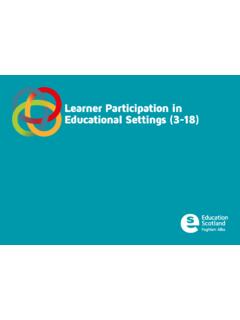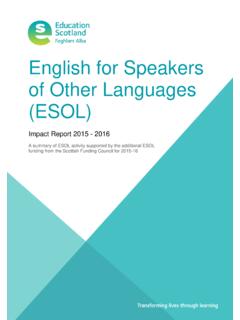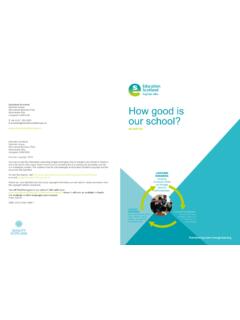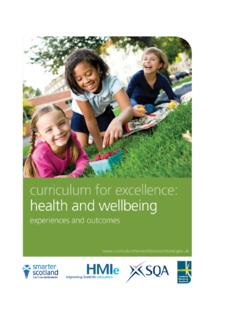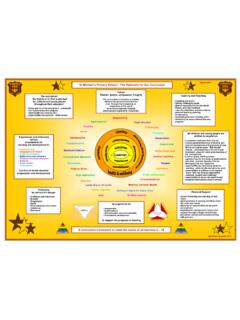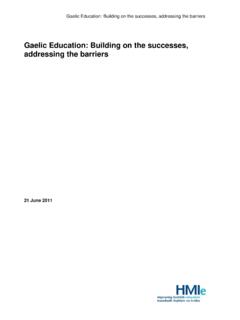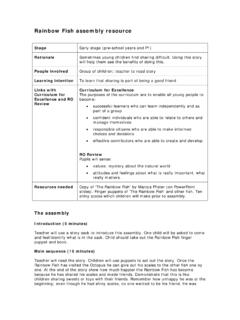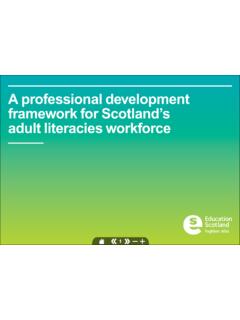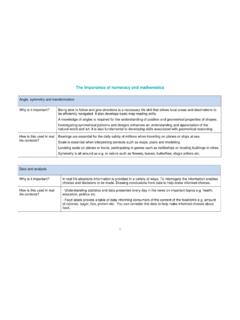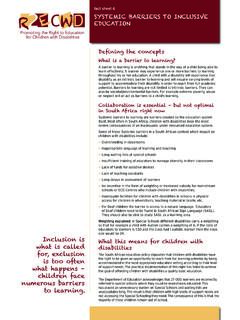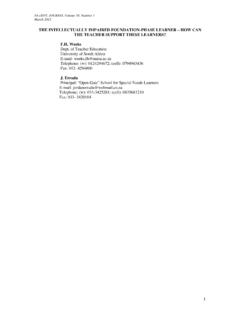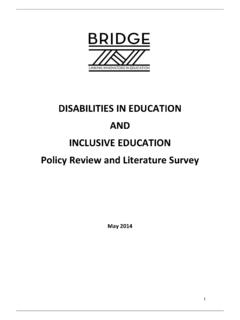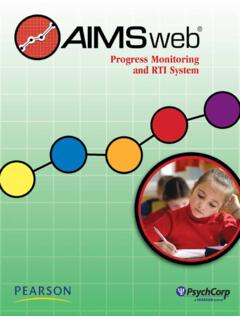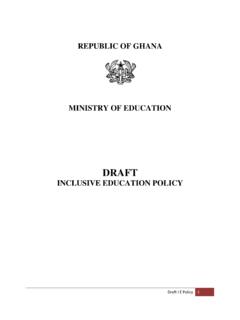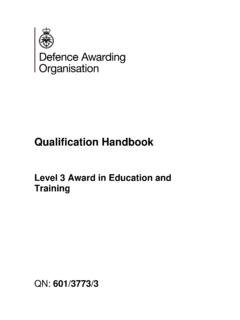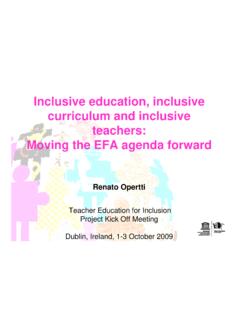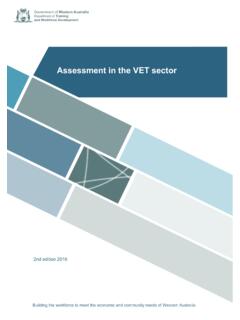Transcription of How good is OUR school? Part 1 - education.gov.scot
1 How good is OUR school? A resource to support learner participation in self-evaluation and school improvementPart OneHow good is OUR school? A toolkit to support learner participation in self-evaluation and school improvement. Part OneIIHow good is OUR school? A toolkit to support learner participation in self-evaluation and school improvement. Part One1 ContentsChief Executive Officer s Foreword 2 Part OneGuidance for school staff and partners working with children and young people 3 What this toolkit is for 4 Why we have introduced this toolkit 5 What we mean by learner participation 7 Creating the right culture for effective learner participation 8 Creating the right culture for meaningful learner participation in self-evaluation and school improvement 9 Features of highly-effective practice 9 Challenge questions 9 Getting your school ready to start using this resource 11 Triangulation of evidence 12 Supporting learners to triangulate evidence 13 Two examples of how schools engage learners in self-evaluation 15 Making time for learners to participate in self-evaluation 17 The ethical issues that might impact on your approach to learner participation 18
2 Appendix 1: Links to the Quality Indicators in How good is our school?, Fourth Edition (2015) 19 Appendix 2: Resources referred to in this publication 20 How good is OUR school? A toolkit to support learner participation in self-evaluation and school improvement. Part One2 Chief Executive Officer s Foreword2018 has been designated as Scotland s Year of Young People. We are celebrating and promoting opportunities that give our young people a stronger voice on matters that affect their lives. We want to challenge perceptions of what young people are capable of and empower them to use their ideas, skills and talents to achieve great things for themselves and with their peers and their communities. This is the heart of what highly-effective learner participation is all about. I am delighted to introduce this addition to Education Scotland s suite of self-evaluation materials.
3 How good is OUR school? (2018) has been produced in collaboration with schools, local authorities and organisations that represent children and young people across Scotland and importantly, with children and young people. They told us of the things that matter most to them about their schools and therefore the things that they feel they should have a say in. This new resource aims to support schools to engage children and young people in self-evaluation and school improvement in ways that enhance learning. It builds on the good practice that already exists in Scotland and supports you to take this aspect of your work to the next level. A strong, inclusive school ethos and a community that actively listens to children s and young people s views underpins effective learner participation. This resource is in two parts:Part One: A guide for staff and partners working with children and young people will support self-evaluation of your current approaches to learner participation.
4 It is intended to be used by school staff and partners working collaboratively with children and young people to evaluate what is working well and consider what would support increased learner participation. Part Two: A self-evaluation framework for use by children and young people includes some suggested activities to support children and young people to evaluate the quality of relationships, learning and teaching, school and community, health and wellbeing and successes and achievements. We are sure that as their skills and confidence increase, children and young people will grow their self-evaluation activity in ways which work best for them in their own school have received very favourable feedback about this resource in the course of its development, in particular about its potential to support innovative approaches to learner participation for children and young people across Scotland.
5 The resource has been created for Scotland s learners with Scotland s learners and educators. I am delighted to launch it for wider use and am confident that it will make a strong contribution to Scotland s Year of Young GormanHow good is OUR school? A toolkit to support learner participation in self-evaluation and school improvement. Part One3 Part OneGuidance for school staff and partners working with children and young peopleHow good is OUR school? A toolkit to support learner participation in self-evaluation and school improvement. Part One4 What this toolkit is forThis publication is intended to support improvement in learner participation in self-evaluation and school improvement. The resource is in two parts. It is important that schools engage with both parts. Part one is about establishing the right culture to support effective learner participation.
6 Part two is about children and young people getting actively involved in one is mainly for school staff and partners working collaboratively with children and young people. It explains why children and young people should be actively involved in self-evaluation and school improvement and the importance of achieving the right culture and conditions for this to be successful. It contains some features of highly-effective practice and challenge questions to support professional dialogue amongst staff and partners. It is really important that the culture and ethos of your school is one that ensures your school community is ready for this level of learner participation. If this sort of culture and ethos is not yet established, then schools should make it a priority to do some work which starts to achieve this. The aim of Part one is to support schools in evaluating the ethos and culture of the school against what is currently considered as strong practice in learner participation and children s two is primarily intended for use by children and young people, although in many cases staff will be working to support them in this.
7 It provides a framework of five themes to support their evaluation of key aspects of the work and life of their school. Each theme includes some examples of what good practice might be and some ideas for gathering and analysing evidence about what is working well and what could be further improved in their school. The aim is that using the framework in groups or classes, children and young people can gather their own evidence and contribute to whole-school self-evaluation. Many of the suggestions can be used as contexts for learning across the curriculum. This is to support and encourage schools to ensure learner participation is broader than pupil councils or other pupil can use the framework in a range of ways. Some may choose to work through all five themes over time. Others may select specific themes linked to school improvement priorities.
8 Some schools may adapt the language of the themes for use with specific groups of children and young people. Some may use this toolkit as a starting point for creating a more bespoke version which better suits the needs of their school community. For example, some schools may like to develop a digital version of the framework. All of these approaches are perfectly acceptable. There is no prescribed way of using the resource. Take from it what is good and right for your school community. How good is OUR school? A toolkit to support learner participation in self-evaluation and school improvement. Part One5 Why we have introduced this toolkitThe quality indicator framework How good is our school? (Fourth Edition, 2015) (HGIOS?4) supports school staff to work together and with their partners, to evaluate what is working well for their school community and what needs further improvement.
9 It contains a clear message that children and young people should be actively involved in self-evaluation and school improvement. Consulting children and young people on aspects of school life that directly affect them is seen as key to improving our education system overall. Learner voice has been developing well across Scotland over recent years but in many schools there is scope to extend this further. Pupil participation is a strong feature of our approach to self-evaluation and continuous All stakeholders, including children and young people, have a shared ownership of this evidence and use it to plan continuous improvement. HGIOS?4 QI Self-evaluation for resource has been developed to support learner participation in school self-evaluation. It has been produced as a result of engagement with groups of children and young people across Scotland.
10 Through a workshop approach, these learners identified key aspects of school life over which they felt they should have some direct influence. Part two of the resource is therefore shaped around these key aspects as organisers which are linked to the quality indicators in HGIOS?4. Using this framework, children and young people can take responsibility for leading aspects of self-evaluation and contribute evidence to support whole-school self-evaluation. This approach provides an opportunity for school staff, partners and learners to engage in meaningful dialogue and to work together in taking forward aspects of school improvement work. Learner participation in self-evaluation and school improvement planning is fundamental to ensuring children s rights within the school context. Article 12 of the UN Convention on the Rights of the Child states that children have the right to have their opinions considered when adults are making decisions about things that affect them.
